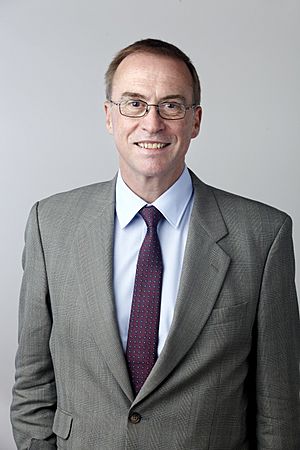Simon Lilly facts for kids
Quick facts for kids
Simon Lilly
|
|
|---|---|

Simon Lilly at the Royal Society admissions day in London, July 2014
|
|
| Born |
Simon John Lilly
January 1st, 1955 London, UK
|
| Alma mater |
|
| Known for |
|
| Spouse(s) | Marcella Carollo |
| Awards | Herschel Medal (2017) |
| Scientific career | |
| Fields |
|
| Institutions |
|
| Thesis | Evolution of radio galaxies (1983) |
| Doctoral advisor | Malcolm Longair |
Simon John Lilly is a well-known professor of physics at ETH Zurich in Switzerland. He is a very important scientist who studies how galaxies form and change over time.
Early Life and Education
Simon Lilly was born in London, UK, on January 1st, 1955. He went to the University of Cambridge for his first degree, where he studied Physics. He finished this degree in 1980.
After Cambridge, he continued his studies at the University of Edinburgh. There, he earned his PhD in 1983. His research focused on how radio galaxies develop. His teacher for this important work was Malcolm Longair.
Career and Discoveries
After getting his PhD, Professor Lilly worked as a researcher at Princeton University in the United States from 1984 to 1985. He then became a professor at the University of Hawaii from 1985 to 1990.
Later, he moved to Canada and became a full professor at the University of Toronto, where he taught from 1990 to 2000. He also led the Herzberg Institute of Astrophysics for two years, from 2000 to 2002.
In 2002, Professor Lilly became a professor at ETH Zurich in Switzerland. He also led the Department of Physics at ETH from 2015 to 2017.
Studying Galaxies
Professor Lilly's main research is about how galaxies form and change. He wants to understand the processes that shape galaxies in different parts of space over billions of years.
- zCOSMOS Project: One of his big projects is called zCOSMOS. With this project, he looks at how galaxies develop over cosmic time. He studies how their properties change depending on where they are in the universe.
- Intergalactic Medium: He also works on finding new ways to detect the intergalactic medium. This is the gas and dust between galaxies. It's important because galaxies form from this material and exchange stuff with it as they grow.
Awards and Recognition
Professor Lilly has received many important awards for his work.
- Fellow of the Royal Society: In 2014, he was chosen as a Fellow of the Royal Society (FRS). This is a very high honor for scientists in the UK. The Royal Society noted that his early work helped scientists measure the history of star formation in the Universe for the first time.
- Herschel Medal: In 2017, he was given the Herschel Medal by the Royal Astronomical Society. This award recognized his work on the Canada-France Redshift Survey. This survey helped scientists measure how bright normal galaxies were over long periods of cosmic time. This work also led to more studies using the Hubble Deep Field.
- Highly Cited Researcher: In 2017 and 2018, he was named a Highly Cited Researcher. This means his research papers are often used and referred to by other scientists around the world.

